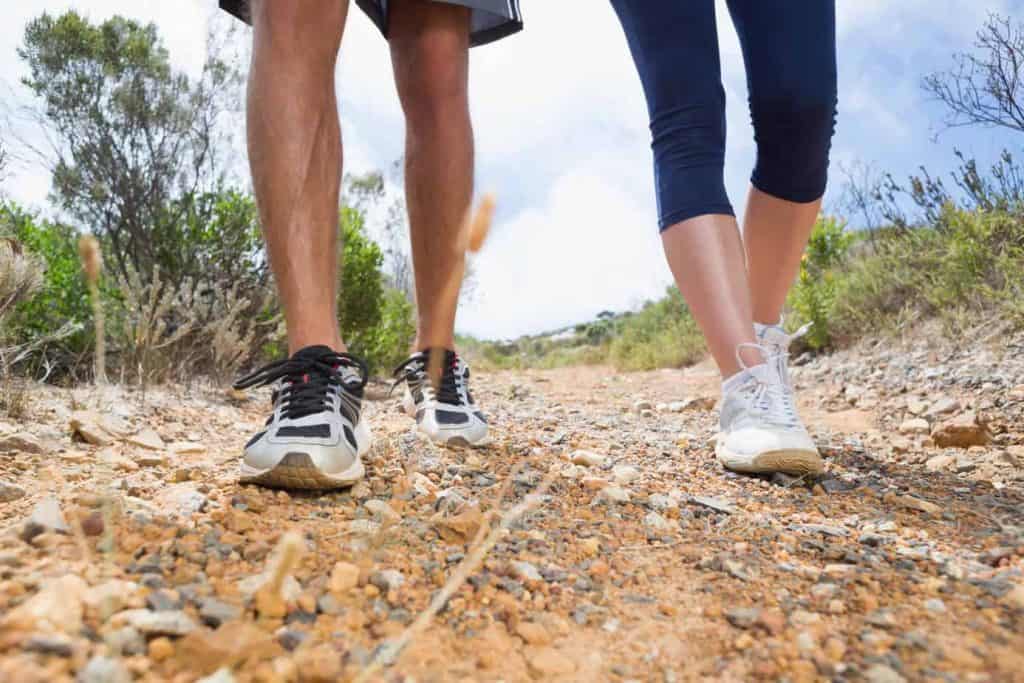Brisk walking….or as I like to call it “being dragged down the street by my rescue pup Zuki” is good for more than just your pet. It’s good for you too.
Walking is the most studied form of exercise and is the most popular form of aerobic exercise. Walking also has the lowest injury rate of any form of exercise.
So what are you waiting for?

Benefits of Brisk Walking
A Daily Walk = A Longer life.
Even a little walking can go a long way in helping you live a longer life. In an American Cancer Society study, researchers found that even low levels of walking are linked with lower mortality, which means walking may help people live longer.
In a review of studies published in 2014 in the International Journal of Behavioral Nutrition and Physical Activity, researchers found that walking for just three hours a week contributed to an 11 percent reduction in premature death risk compared with those who did not walk.
That’s barely 30 minutes a day for a longer healthier life.
Lower Stress and Raised Spirits
Like other types of aerobic exercise, brisk walking—especially out in nature—stimulates the production of endorphins that help improve your mental state.
Being outside in the fresh air can do wonders for a bad mood – it’s one of the reasons I always start the day brisk walking with my dog.
One study found that by walking just 30 minutes per day, individuals with major depression reported a 40 percent improvement in well‐being and an 85 percent increase in energy levels as opposed to non-walkers in the study.
Little Effort = Improvements
Even a single exercise session can produce improvements.
A study by University of Texas researchers had people with major depressive disorders either rest quietly or walk on a treadmill for 30 minutes and tested their mood afterward. Both groups saw improvements in mood, but those who walked on the treadmill had more positive feelings of well-being and vigor.
The study was published in the December 2005 issue of Medicine and Science in Sports and Exercise.
Daily Walk Means Better Memory and Brain Health
A clinical trial of older adults in Japan published in the Journal of the American Geriatrics Society in 2015 found that after 12 weeks, men and women in a prescribed daily walking exercise group had significantly greater improvements in memory and focus compared with those in a control group who received no exercise advice and were told just to carry on with their usual daily routine.
In a study of 120 seniors, brain scans showed that the size of the hippocampus increased in size by about 2 percent among walkers, which was the equivalent of reversing age-related loss by one to two years.
When I’m walking alone, I always listen to one of the best short podcasts I’ve found so I can learn, improve my mind and improve my health at the same time.
Walking can even be a great balance exercise for seniors. All movement helps!
Lower Diabetes Risk with an Evening Walk
Brisk walking is an excellent tool for controlling Type 2 diabetes and improving health for people with diabetes. Walking workouts can help you maintain a steady blood sugar level and body weight if you have Type 2 diabetes.
Higher blood glucose levels are a risk factor for diabetes, and the National Walkers’ Health Study found that walkers had a 12 percent lower risk of type 2 diabetes.
An evening walk can be the perfect way to wind down after a busy day and is a great way to connect with your family.
Walking After Dinner Can Improve Heart Health
Brisk walking is as good as running for reducing blood pressure and cholesterol, two main causes of heart disease.
And it doesn’t matter how fast you go either…
Improving heart health is a matter of how far you walk or run, not how long, or how fast.
Walking after dinner can be a great way to get your digestion started, get you up and off the couch and enjoy your neighborhood. Evening walking benefits are proven to help you manage stress and be healthier.
Morning Walk = Weight Loss
If you spend 30 minutes a day brisk walking and include enough activity throughout the day to reach the combined total of 10,000 steps, you’re burning about 500 calories a day, which means you’re losing one pound each week.
If you have tried any of the popular diets for women, you know that one pound a week can really add up.
A study published in the International Journal of Obesity proved that those who walk more and sit less have a lower BMI, which is one indicator of obesity.
In the study, those who took 15,000 or more steps per day tended to have BMIs in the normal, healthy range.

Getting the Best Daily Walk Benefits
Any amount of walking is good for you, but you can really kick up your health benefits if you briskly walk at least 30 minutes a day, 5 days a week. So doable!
1. Walk as Much as You Can
The University of Warwick study compared people with at least one sign of metabolic syndrome—which is a group of risk factors (high blood pressure, fat around the waist, high blood sugar, and high triglycerides and cholesterol) that lead to heart disease—to those with no risk factors.
They found that those who got the least activity had the most risk factors, and those who walked the most—accumulating at least 15,000 steps per day—had healthy BMIs, smaller waists, lower cholesterol and blood pressure, and better blood sugar control.
2. Aim for 10,000 Steps
Many people aim for a daily goal of 10,000 steps (or about 5 miles)—and an industry of fitness tracking devices has emerged to support them—but that magic number didn’t originate from scientific research, says John Schuna Jr., Ph.D., assistant professor of kinesiology at Oregon State College of Public Health.
“It was first used in a Japanese marketing effort associated with one of the first commercial pedometers.” The device was called “manpo-kei,” which literally means “10,000 steps meter” in Japanese.
“The 10,000 steps goal is thought to be a realistic minimum, and it’s good, but for complete risk reduction, people should aim for more,” says William Tigbe, M.D., Ph.D., a physician and public health researcher at University of Warwick and lead author of the study showing that 15,000 steps per day can lead to greater benefits.
“In our study, those who took 5,000 extra steps had no metabolic syndrome risk factors at all.”
3. Pick up the Pace
Another way to get more out of even a shorter walk is to do it faster. A recent study looked at not just the total number of steps people took per day but also how quickly they took them.
“Those who had a faster stepping rate had similar health outcomes—lower BMI and lower waist circumference—as those who took the most steps per day,” says Schuna, one of the study authors.
He recommends trying for a minimum of 100 steps per minute (roughly 2.5 to 3 miles per hour) or as brisk a pace as you can (135 steps per minute will get you up to about a 4 mph pace).
4. Break it Up
“We cannot accumulate 15,000 steps in leisure time only,” reasons Tigbe. “But if you take walking breaks throughout the day, it is doable.”
Aim for bouts of 10 minutes or more at a time of brisk walking. You’ll get in more steps and decrease the amount of time you spend being sedentary—which is a big risk factor for heart disease.
My fitbit actually vibrates every hour to remind me to get up from my desk and get moving.
5. Try Intervals
Instead of doing an entire 30-minute walk at the same moderate pace, try high-intensity interval training (HIIT). Alternate between 30-second to 1-minute bursts of faster walking, followed by a minute or two of slower-paced recovery.
In one study researchers compared people who did no exercise with those who walked at a steady, moderate pace and those who mixed high and moderate intensity. The researchers found that the group that cranked up the intensity had the greatest reductions in waist circumference and abdominal fat.
6. Climb That Hill
Brisk walking on hills is like getting a two for one exercise bonus. When you increase your intensity, such as walking up a steep hill or going up stairs, you get the equivalent benefit in half the time.

7. Get a Dog
I walk so much more because I have a dog. Even on days I would rather snuggle under the covers and stay in bed, my pup manages to get me outside. It’s good for dogs and has great health benefits for their owners.
8. Stay Motivated
Stay motivated every day by seeing your progress! I love using stickers in my planner to track my daily step count.
Go Take a Walk
So what are you waiting for?
Lace up those shoes and get outside.
Want To Remember this Brisk Walking Post? I’d Love it if you’d Pin It To Your Favorite Healthy Living Pinterest Board And Pass It On!


